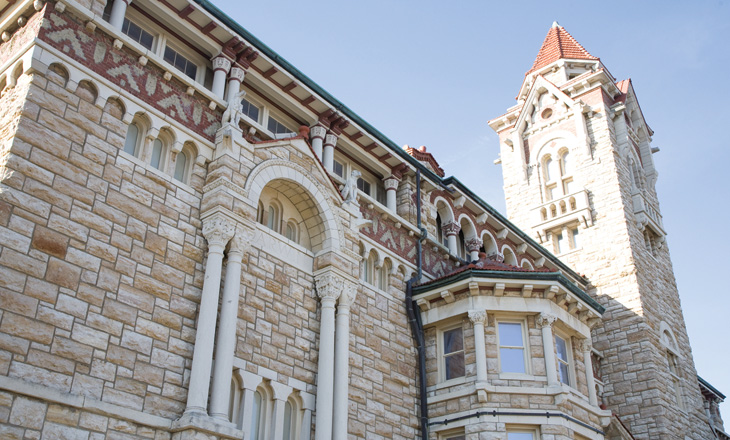| First Quarter 2013 | story by JOE MONACO, UNIVERSITY OF KANSAS

The history of the University of Kansas’ Lawrence Campus is being recognized and preserved by the creation of a historic district.
The Kansas Historical Society’s Historic Sites Board of Review voted to create a historic district comprising the heart of the Lawrence campus. The district is now listed in the Register of Historic Kansas Places and has been forwarded to the National Park Service for consideration for the National Register of Historic Places. “The beauty of our campus doesn’t come from any one building or place, but rather from the whole environment that has been created on Mount Oread,” Chancellor Bernadette Gray-Little said. “This district will help us preserve that environment so future Jayhawks may enjoy the same beautiful, historic campus as their predecessors.” The University of Kansas Historic District covers the period of 1863-1951 and comprises 52 resources—buildings, landmarks and landscapes. Twenty-six of those are considered contributing resources, and six others are already listed individually in the National Register of Historic Places. Gaining new recognition through inclusion in the district are buildings such as Watson Library, landmarks such as the World War II Memorial Campanile and landscapes such as The Hill, which graduates walk down during Commencement.
The district was created with support from the Historic Mount Oread Friends, which provided $21,000 in funding for the drafting of the nomination. Members of the organization worked with the Campus Historic Preservation and Heritage Advisory boards to define the district in consultation with Rosin Preservation, Treanor Architects and landscape historian Carol Grove. “The Historic Mount Oread Friends are loyal supporters of our university. Their dedication and generosity will help preserve the beauty of our campus for generations to come,” Gray-Little said. Creation of the district builds on the work undertaken through a 2006 grant from the J. Paul Getty Trust to create a preservation master plan to guide the future preservation and development of the campus. To be eligible for inclusion in the state or federal registers, properties must generally retain their historic appearance, be at least 50 years old and have demonstrated significance, either historically or architecturally. Historic districts generally must be contiguous. Inclusion in the registers makes properties eligible for state and federal financial incentives, such as tax credits. The National Register of Historic Places is the country’s official list of historically significant properties, while the Register of Historic Kansas Places performs the same role at the state level. Properties included in the National Register are automatically listed in the State Register; however, not all properties listed in the State Register are included in the National Register.
KU BIODIVERSITY INSTITUTE RENOVATION COMPLETED
The KU Biodiversity Institute has announced completion of a twoyear, $3.5 million renovation that has modernized the laboratories in 110-year-old Dyche Hall for 21st century research and student
training about the life of the planet. In the new facilities, KU faculty, staff, students, and visiting scholars will be able to conduct innovative research in biodiversity science, from discovering and documenting the diversity of the world’s plants and animals; to exploring their genetics, anatomy and evolution; to forecasting the potential spread of diseases and harmful invasive species; to investigating the environmental consequences of decreasing water on the Great Plains. Through a partnership of federal, state and private resources, the Biodiversity Institute created eight new laboratory spaces that will greatly increase the research capacity and capabilities of the institute. The National Science Foundation awarded the Biodiversity Institute $1.5 million for the project through a program titled Academic Research Infrastructure: Repair and Renovation. The institute was the nation’s only university biodiversity organization chosen for such a project; to qualify, an organization had to demonstrate its research excellence, and its potential for increasing that excellence by replacing antiquated or outmoded laboratories. In Dyche Hall, some of these facilities were more than 45 years old. Major state investments in the project allocated by the university included almost $2 million for electrical, HVAC and cyber connectivity. In addition, private funding helped equip the laboratories and create new spaces to accommodate graduate-student research. Previous to the improvements, cyber bandwidth was insufficient for large-scale data access, complex geographic and modeling analyses, or research networking within KU and externally. Outmoded electrical transformers and overloaded circuits caused power outages and shutdowns of critical equipment needed to preserve animal and plant tissues, and to archive and serve data to institute and global community networks. Many of the institute’s.

1 Comment
hey there and thank you for your information – I have definitely picked up
something new from right here. I did however
expertise some technical issues using this web site, as I experienced to reload the website
many times previous to I could get it to load correctly.
I had been wondering if your web hosting is OK? Not that I’m complaining,
but sluggish loading instances times will very frequently affect your
placement in google and could damage your high-quality score if ads and marketing with Adwords.
Anyway I am adding this RSS to my e-mail and could look out
for a lot more of your respective exciting content.
Ensure that you update this again soon.